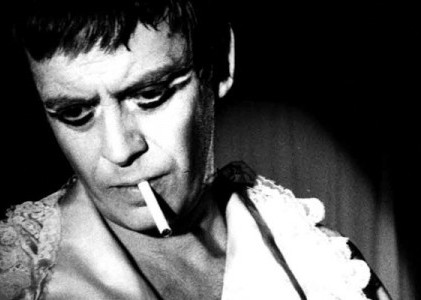Alone Against All
"Whatever the public blames you for, cultivate it: it is yourself." This is the sage advice of Jean Cocteau, and few took it so much to heart as Carmelo Bene, the mosquito in the room of the late-'60s art-house scene, who self-styled himself into one of the great cultural antagonists of the 20th century.
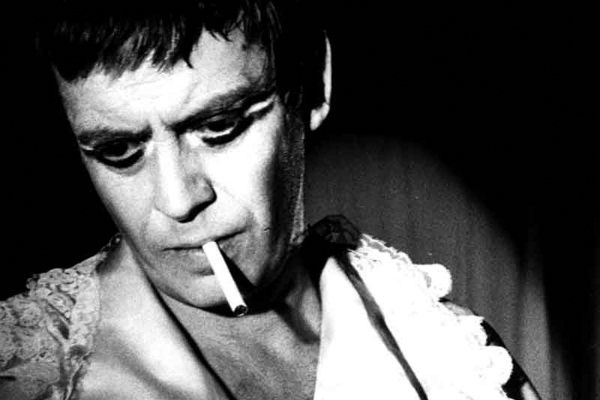
Carmelo Bene
When Bene, actor, director, playwright, novelist, memoirist, poet, and provocateur, died in Rome, aged 64, in 2002, the consensus was that he had been a figure of artistic significance since the moment of his first public success, a 1959 performance of Albert Camus's Caligula. Whether Bene's significance was that of a maestro or that of a natural disaster has been less readily agreed upon.
The catastrophic quality of Bene's work is implicit in the best-known English-language assessment of his film art—five features and a handful of shorts, produced between 1968 and 1973. In his 1974 Film as a Subversive Art, the late, lamented Amos Vogel described Bene as a kind of cinematic volcano: "Bene's films are visual, lyrical, and auditory cataclysms, whose lava-like outpourings are of unequalled hallucinatory perversity."
More recently, it has been difficult for anyone to form an educated opinion on the subject of Bene outside of Italy. I hesitate to call it Bene's "homeland," for though he was born in 1937 near Lecce, in the heel of the Italian boot—apt for a sadist—the contentious Bene didn't care to acknowledge his birthright, telling Cahiers du cinéma's Jean Narboni in a 1968 interview: "Culturally, I'm not Italian but Arab."
Soon it will be less difficult to experience this mad Arab's one-man jihad, sacking the treasures of Western art. RaroVideo, a company specializing in neglected Italian fare, has recently announced the forthcoming release of Bene's Silver Lion-winning 1968 debut feature Our Lady of the Turks on Region 1 DVD, and an extraordinary variety of his work is already viewable on YouTube, sans subtitles. (You don't need them.)
This is all welcome news, but the real event is Rome's Cineteca Nazionale's having struck new prints of Bene's cinematic corpus, which have recently appeared at Cambridge's Harvard Film Archive and are now traveling to Anthology Film Archives. Bene's films beg to be seen on the big screen. In part this is because it's the best way to appreciate their overbearing opulence. In part it's because, when watching them in the privacy of one's living room, it is very difficult not to succumb to the desire to turn these haranguing, babbling, burbling movies off—"less difficult to experience" doesn't mean the same thing as "easy to watch."
Reporting from a Venice Film Festival where Bene was the single noteworthy Italian director presenting, having crossed a picket line protesting the organizers, Gideon Bachmann's review of Bene's Salomé from the Winter 1972-'73 Film Quarterly yields a typical (allergic) reaction: "I have never liked Carmelo Bene. He is ugly, arrogant, self-centered, politically neutral—and genial. His work in the theater, where he began his enfant-terrible career, was flamboyant, formalistic, drooling, and often naive. His stock-in-trade is épater l'intellectuel!, and both on stage and on the screen his works are beset by ostentation....Exposing oneself to a work by Carmelo Bene, whether on stage or in the cinema, one is constantly sandwiched between fatigue of the eye and frustration of the soul." And yet, concludes Bachmann, faced with the undeniable evidence of Salomé, "while rejecting [Bene] as a person, I am forced to appreciate him as an artist."
A brief portrait of that artist: Having avoided military service by posing as a homosexual, Bene headed for Rome at age 17, leaving behind Apulia, his Catholic upbringing, and his Jesuitical education—later the author of cinema's great auto-crucifixion scene in Salomé, Bene was one of those lapsed believers whose scriptural education and negative zealotry could elevate churlish heresy to the level of great religious art. After enrolling at the Accademia Nazionale d'Arte Drammatica "Silvio D'Amico" in 1957, Bene promptly dropped out. He debuted onstage the following year in a Nino Massari play, but it was Alberto Ruggiero's production of Caligula that made Bene a star of Rome's (literally) underground "cantine teatrali," or basement theater, in a role that anticipated a career much preoccupied with the degenerate and decadent. Operating his 26-seat Teatro Laboratorio in bohemian Trastevere, Bene was famously involved in a scandal that involved an Argentine ambassador being pissed on. No less pertinent to his future filmmaking, he began to develop a repertoire that combined standard bearers of the avant-garde (Alfred Jarry, Mayakovsky) with fractured versions of the classics (Marlowe, Shakespeare, Pinocchio).
Aside from his own films, Bene would be a fixture in outré Italian productions of the late '60s and '70s, when Rome was an amphetamine-fueled Hollywood-on-the-Tiber. Atypically restrained, Bene played Creon, the uncle and brother-in-law of the doomed Oedipus Rex in the 1967 interpretation of Sophocles by Pier Paolo Pasolini (also featuring Julian Beck of New York's Living Theatre, whose work Bene deflected comparisons to). In Franco Brocani's 1970 Necropolis, Bene appears looking incredibly depraved and drunk on Johnny Walker, opposite Warhol starlet Viva; in Mario Schifano's 1972 Umano non umano, Bene and longtime partner and collaborator Lydia Mancinelli play an anxious eight-minute domestic bedtime scene, her settling in and reading while he smokes at the edge of the bed, fidgets, and finally settles down to mysteriously rumble under the covers.
Here a few words about Bene's screen presence are in order. A Guardian obituary hailed him as "undoubtedly the greatest guitto (barnstormer) of the contemporary Italian stage." Onscreen, Bene's guttural tantrums, sense of the grand and grotesque, and unabashed relish at tearing through trunks of costumery suggest a missing link between Orson Welles and Alice Cooper. Or perhaps there is a more apt contemporary reference; in the Cahiers interview, Narboni asks Bene about Jerry Lewis. Bene claims ignorance, but the comparison holds water, for despite coming from vastly different traditions—Lewis from American vaudeville, Bene from the European avant-garde—both specialized in playing the quixotic man-child, by turns louche, zombified, pompous, groveling, narcissistic, ogreish, and simpering, eyelash-batting innocent. Like Lewis, who served his apprenticeship under former Looney Tunes director Frank Tashlin, rubber-faced Bene was essentially a live-action cartoonist. Unlike Lewis, Bene's background was unmistakably Catholic, with all the baggage that implies. His preferred pitch of performance was that of a mad street-corner shouter, his voice wildly switching registers as though there were a dozen different men contending to speak through him. A line in Our Lady of the Turks has it that "being a saint means giving up control"—but to a devout Italian audience of the period, Bene, with an unearthly growl emanating from the back of his throat, undoubtedly seemed more like a man possessed.
Bene first succeeded in putting his demons on film in the 25-minute Hermitage, undertaken in 1968 as a sort of dry run for his forthcoming first feature. Padding around Suite 804 in Rome's Hotel Hermitage, Bene is haunted by a bronze-skinned female apparition played by Mancinelli and by bursts of Verdi's A Masked Ball, the latter cued by the onscreen presence of an urn of cyan roses. Bene spends much of the film swaddled in a diaper-like loincloth, undressing and dressing and undressing before a gilt-framed rococo mirror before finally donning a gold-embroidered robe fit for a sultan. Lolling restlessly, his body is rag-dollish, his head rolls unsupported on his neck, his face is obscured beneath a layer of what appears to be flaking plaster. With his sunken, heavy-lidded eyes, Bene has the appearance of a Caravaggio adolescent grown up and mired in debauchery.
In Hermitage we can identify a number of presiding themes and techniques: the indolent tossing-and-turning performance, pricked with unquenchable horniness; the tawdry theatrical-gels-and-fake-flowers opulence; the image of the decomposing mask, which would reach an apotheosis in Salomé's skin-peeling "Dance of the Seven Veils." The furor of the multi-layered soundtrack, often a babble of overlapping voices, assembled in post-sync—a continuity from Bene's stage productions, which experimented with multiple mics and tape tracks. The butcher's-block editing, displaying what Bene called his "surgical indiscipline of montage," full of counterintuitive cuts designed to bait, aggravate, overwhelm, frustrate, and nauseate, which would build, in the films to come, from pelting to full-blown tempest.
The rehearsal of Hermitage completed to his satisfaction, Bene commenced with Our Lady of the Turks. Bene had first given this title to an autobiographical and historical novel published in 1966 by Milan's SugarCo, the material of which he rewrote for the stage before finally preparing it as a film. Bene shot in his home province, making expressionistic use of architectural landmarks in and around the port city of Otranto, including the 19th-century Moorish-style Palazzo Sticchi and the Cathedral, with its reliquary of martyred bones, a memorial to a 1480 sneak attack by the Ottomans. Bene plays the lead(s), a miraculously survived and still-living witness of the Turkish slaughter of Christians who is sometimes a bandage-swaddled slapstick hero, sometimes a knight-errant, sometimes a mad monk and his own molested novice—a literal staging of the back-and-forth, one-man, two-voices arguments that recur in Bene's vocal performances. In each of these iterations, he is on the trail of Saint Margherita, played by Mancinelli, whose curtained red hair against the blue Aegean is but one lovely color effect in this vibrant, chromatic procession, a film veined with moments of startling Mediterranean beauty that Bene systematically subverts with ignominious hamming, at one point walking into a Romantic waving field of wildflowers only to whoopee-cushion the lovely scene with a pratfall.
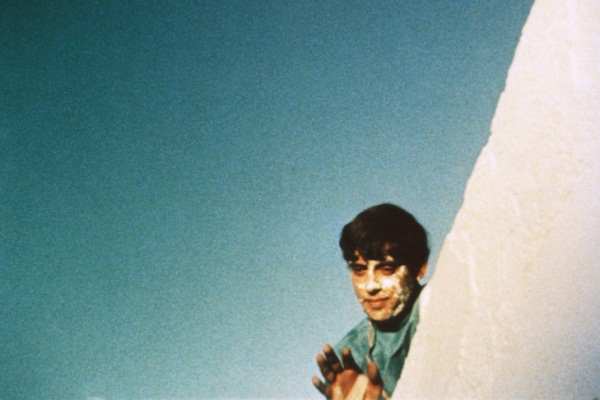
Our Lady of the Turks
It's said that Douglas Fairbanks Sr., at the height of his fame, would engineer every aspect of his robust films so as to make his actions seem effortless. If a scene called for Fairbanks to bound onto a tabletop, for example, he would have the table's legs sawed down until it stood at the exact height that he could comfortably jump without appearing to tax himself. Bene's approach is virtually the exact opposite—simple acts are made to seem impossibly complex, inelegant, and even excruciating, from throwing oneself off a balcony (Our Lady of the Turks) to serving a cup of tea (Don Giovanni). Most difficult of all is making love, which in Bene's films takes on the aspect of a lopsided wrestling match, attempted in spite of the insurmountable intervention of, say, a fettering suit of armor (Our Lady of the Turks and One Hamlet Less) or impotent old age and desiccation (Capricci and Salomé). It's as though Bene was formatively impressed by Buñuel's scenes of frustrated passion—the young man struggling toward consummation, yoked to the immobile cultural cargo of a grand piano, clergymen, and Commandment tablets in Un Chien andalou, or practically the entirety of L'Âge d'or—and embarked on a career of playing elaborations on them.
Capricci (1969) begins with another scene of interminable flailing, Bene engaged in a knock-down, drag-out, hammer vs. sickle duel with a painter, played by Tonino Caputo, in the latter's studio. From here, the film forks into two narratives. One has Bene, wracked by an agony of giggles, wearing a red scarf, pleather jacket, and spray of gore, trapped in a junkyard demolition derby with Au hasard Balthazar's Anne Wiazemsky. In the other, a woman played by Ornella Ferrari plots the assassination of her feeble, hacking husband by way of a poisonous painting, a story that at one point quite abruptly shifts its scene to the clapboard set of a spaghetti western.
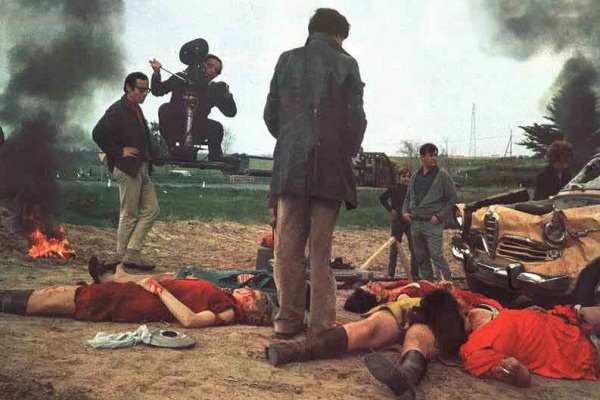
Capricci
Like most of Bene's theatrical work, Capricci is an "interpretation" of an existing text. The ostensible source is an unattributed Elizabethan drama concerning a case of mariticide called Arden of Faversham. Allen S. Weiss, in The Drama Review, describes Bene's adaptation technique thusly:
To work in the "hollow" spaces of the text; to eliminate or "subtract" the major dramatic structures of a play in order to reveal a revolutionary "minor" discourse; to break open the representational system of both text and theatre....Bene insisted that he never offered a personal interpretation of Shakespeare (and, by extension, the other classics he treated), but rather a critique. What he attempted was to unfix their classicism, undo their ideology, and disrupt their established theatricality...not to contest official theater, but to proffer "the spectacle of the ridiculousness of spectacle."
There is a scene in Capricci where Bene gets out of the banged-up car in which he and Wiazemsky are bloodying up the upholstery, to get under the hood. Bene begins as though to attempt a repair, then commences wreaking havoc with pliers and hammer. This summarizes Bene's technique of adapting literature: He's no mechanic, but a brake-cutting vandal.
After putting in work on what ended up as another of cinema's many failed Don Quixotes, the next canonical work to receive Bene's wrecking-ball renovation was, in 1970, Don Giovanni, a collision of Mozart's opera buffa and Barbey d'Aurevilly's "Le plus bel amour de Don Juan." Bene plays the Don, with Mancinelli his lover (alternately stripped bare and clothed, from shot to shot), and Gea Marotta her obstinate unibrowed girl-child, whose affections the Don attempts to ply with badgering puppet shows, toward unwholesome ends, as she nervously slurps on her rosary and does exercises on a long-dead piano. The soundtrack is a combination of Mozart's aria, a fell wind blowing, obnoxious percussion, teeth-grinding clatter, and readings from Spanish, French (St. Thérèse de Lisieux), Italian, and English (Shakespeare's Sonnet No. 123; a pecksniffish Brit voice reciting Delacroix's criticisms of Ingres, many of which might equally be leveled at Bene; a juicy line from Borges, tying together two of Bene's great preoccupations: "Copulation and mirrors are abominable because they multiplicate the number of human beings").
Given his career-long siege on the storehouses of Western high culture, in which Don Giovanni is but one skirmish, Bene has been rightly regarded as a disciple of Antonin Artaud ("What is most important, it seems to me," Artaud wrote, "is not so much to defend a culture whose existence has never kept a man from going hungry, as to extract, from what is called culture, ideas whose compelling force is identical with that of hunger"). Bene shared with Artaud a desire to burn the cobwebs away from theater and shake loose the vital "compelling force" of the texts that he attempted—and here it should be noted that a profound mistrust of women was a consistent theme of those texts. It is certainly at the heart of that old misogynist Mozart's Don Giovanni, whose Act 2 has a duet of priests earnestly warning "Beware of woman's crafty scheming/This is the Order's first command!/Many a man of wiles not dreaming/was tempted and could not withstand/But then he saw he was mistaken/The truth he came to know too late/At last he found himself forsaken/Death and damnation were his fate." Given Bene's contentious relationship with the works that he throttlingly interpreted, they become as much confrontations and auto-critiques as confessions of Bene's own troubles with women—certainly this Don Giovanni is more concerned with the swinish tyranny of his clammy, feverish Don than with women's duplicity.
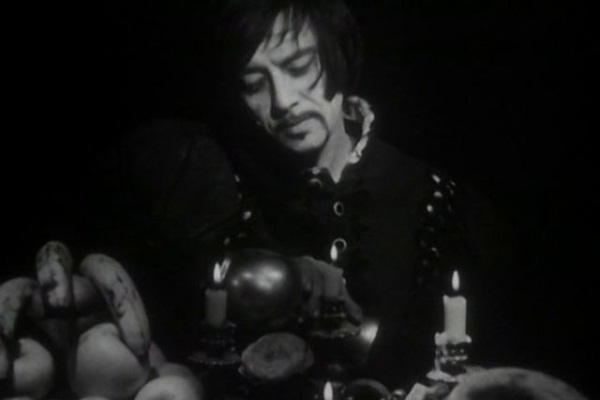
Don Giovanni
True to form, Bene's next production centered on a hoarse shouter-down of feminine perfidy, John the Baptist. Salomé was Bene's most ambitious work to date, a Super-16 superproduction filmed on a Cinecittà soundstage. The source is Oscar Wilde's 1891 play of the same name, which Bene first staged—or perhaps regurgitated is the word—at Rome's Teatro delle Muse in 1964, with a cast drawn in part from the Ceccano prison.
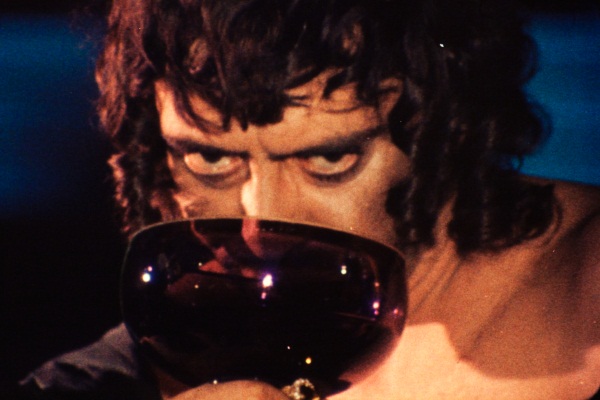
Salomé
Bene stars as Herod, Tetrarch of Galilee, wearing a crown of greasy ringlets; his stepdaughter, Salomé, is played by Donyale Luna, a six-foot-two Detroit-born African-American model whose extraterrestrial exoticism had previously been exploited by Otto Preminger's woeful Skidoo and Fellini's Satyricon. An animated camel through a needle's eye and flushed butts being swatted with feather paddles are the opening fanfare of Bene's blasphemous carnival, staged in a floating world of fruity neon tracery and heaped flora, set against a black background and immersed in black water. Actors jabber out across ambiguous distances, everything reflected in the pool and refracted through the rude prism of Bene's flashing editing.
Bene later cited the overwhelming work involved in his lapidary productions as his reason for quitting filmmaking, describing the pre-production of Salomé: "Twenty-two million plastic roses arrived from Paris and Naples, painted fluorescent colors one by one..." After such an exhausting effort, there can't help but be an element of slackening and anticlimax in Bene's follow-up and final film, 1973's One Hamlet Less, which returned him to a text he'd first manhandled in 1961 at the Teatro Laboratorio (and which he would plunder again for Italian television in 1978 and '90).
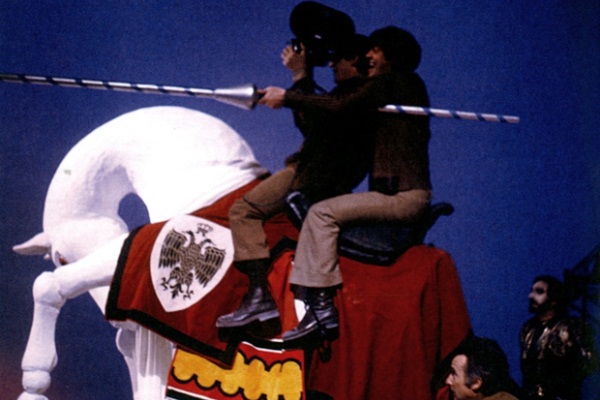
One Hamlet Less
As in Capricci, One Hamlet Less braids together two distinct narrative strands. One concerns a troupe of actors led by Bene and Mancinelli, who's credited as "Kate, the First Actress in Elsinore." The other is Shakespeare's Hamlet, played on a soundstage, with Bene in the lead role. The text, in by-now familiar fashion, is demolished, its ruins subsequently raked through and reassembled with ill-fitting spare parts, including the Symbolist free verse of Jules Laforgue, Freud's Interpretation of Dreams (significantly mouthed by that fusty old know-it-all, Polonius), and a play-within-a-play scene from Arthurian legend acted out before a blue-screen backdrop, which associates fickle Guinevere with fickle Gertrude. Bene makes it clear, however, that he isn't obediently parroting the sexual skittishness of Shakespeare and his Dane, but trying to flee its legacy, as that of a cultural patriarchy: "I don't care about my throne," cries Bene the actor to Kate, the First Actress in Elsinore. "The dead are dead. Let's see the world. Paris, my life: To us!"
With this, Bene retreated from movie theaters, but his public struggle with the accreted centuries of Western civilization continued unabated until his death. He continued to televise performances—here there is material for another essay entirely—and gave rock-star performances worthy of arena-era Pink Floyd, reading Byron's Manfred at La Scala, declaiming The Divine Comedy to an audience of 100,000 from Bologna's medieval Torre degli Asinelli.
For all this public breast-beating, Bene's howling, alone-against-all protest was more a cultural brushfire than a Vesuvius—but the artifacts left behind in the embers are still livid and vivid, punk avant la lettre. And the controversy continues! Most recently, Bene made the news when his sister, Maria Luisa Well, demanded an investigation into the circumstances of his death, accompanied by accusations of foul play—this despite the fact that it was public knowledge that the ailing, hard-living Bene had had two quadruple bypass surgeries. But even if Bene wasn't murdered, he lived in such a way as to assure that plenty would've been happy to do the job—and like a truly great pest, he won't stay dead. ![]()
LATEST ARTICLES
-20140814-173707-thumb3.jpg)
Fighting Words
by Imogen Sara Smith
posted August 12, 2014

Fighting Words, Part 2
by Imogen Sara Smith
posted August 20, 2014

On the Margins: The Fil…
by Andrew Chan
posted August 12, 2014

Robin Williams: A Sense…
by David Schwartz
posted August 12, 2014
 Alone Against All
Alone Against All
THE AUTHOR
Nick Pinkerton has written about films in The Village Voice, Reverse Shot, and Stop Smiling magazine. He is a product of Cincinnati, Ohio, and currently lives in Brooklyn, New York.
More articles by Nick Pinkerton
